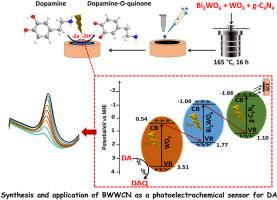Bi2WO6/WO3/g-C3N4三元纳米复合修饰玻碳电极用于多巴胺的光电检测
IF 4.7
3区 材料科学
Q2 MATERIALS SCIENCE, MULTIDISCIPLINARY
引用次数: 0
摘要
多巴胺是一种重要的神经递质,参与重要的生理过程,其敏感性和选择性检测具有重要意义。在这项工作中,我们开发了一种基于三相Bi2WO6/WO3/g-C3N4 (BWWCN)复合材料的新型光电化学(PEC)传感器。三种组分之间的协同作用增强了光吸收、电荷分离和电子转移。采用水热法合成了BWWCN,并将其沉积在玻璃碳电极(GCE)上。XRD, TEM和UV-Vis表征证实了复合材料的成功形成。光致发光(PL)分析显示,电子-空穴复合明显减少,顺序为Bi2WO6>;WO3>g-C3N4>;BWWCN。多巴胺光电传感器线性检测范围宽(0.01 ~ 110 μM),检出限低(0.01 μM),稳定性和重复性好。它的有效性在唾液样本中得到证实,证实了它在现实世界中监测多巴胺的潜力。本文章由计算机程序翻译,如有差异,请以英文原文为准。

Bi2WO6/WO3/g-C3N4 ternary nanocomposite-modified glassy carbon electrode for sensitive photo-electrochemical detection of dopamine
Dopamine is an essential neurotransmitter involved in critical physiological processes, and its sensitive and selective detection is of great importance. In this work, we developed a novel photoelectrochemical (PEC) sensor based on a triphasic Bi2WO6/WO3/g-C3N4 (BWWCN) composite. The synergistic interaction among the three components enhances light absorption, charge separation, and electron transfer. BWWCN was synthesized via a hydrothermal method and deposited onto a glassy carbon electrode (GCE). XRD, TEM, and UV–Vis characterizations confirmed the successful formation of the composite. Photoluminescence (PL) analysis revealed significantly reduced electron–hole recombination, following the order Bi2WO6>WO3>g-C3N4>BWWCN. The dopamine photoelectrochemical sensor showed a wide linear detection range (0.01–110 μM), a low detection limit (0.01 μM), and excellent stability and reproducibility. Its effectiveness was demonstrated in saliva samples, confirming its potential for real-world dopamine monitoring.
求助全文
通过发布文献求助,成功后即可免费获取论文全文。
去求助
来源期刊

Materials Chemistry and Physics
工程技术-材料科学:综合
CiteScore
8.70
自引率
4.30%
发文量
1515
审稿时长
69 days
期刊介绍:
Materials Chemistry and Physics is devoted to short communications, full-length research papers and feature articles on interrelationships among structure, properties, processing and performance of materials. The Editors welcome manuscripts on thin films, surface and interface science, materials degradation and reliability, metallurgy, semiconductors and optoelectronic materials, fine ceramics, magnetics, superconductors, specialty polymers, nano-materials and composite materials.
 求助内容:
求助内容: 应助结果提醒方式:
应助结果提醒方式:


